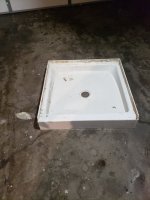Joe Rausch
New Member
Hello,
My house was built in 1975 and I'm remodeling my current stand up shower, which is located in the basement of my home. I removed the shower pan I noticed there was a cast-iron drain underneath the shower pan. The purpose of this conversation is to look for advice on either replacing the cast-iron drain or leave it? My gut feeling is that I will need to replace it because of the concern of water stagnating underneath the shower pan.




I attached a bunch of pictures to show you my current situation and to give you an idea of the project.
Thanks,
Joe
My house was built in 1975 and I'm remodeling my current stand up shower, which is located in the basement of my home. I removed the shower pan I noticed there was a cast-iron drain underneath the shower pan. The purpose of this conversation is to look for advice on either replacing the cast-iron drain or leave it? My gut feeling is that I will need to replace it because of the concern of water stagnating underneath the shower pan.
I attached a bunch of pictures to show you my current situation and to give you an idea of the project.
Thanks,
Joe
Attachments
Last edited by a moderator:

